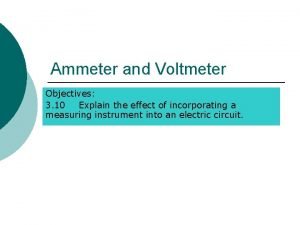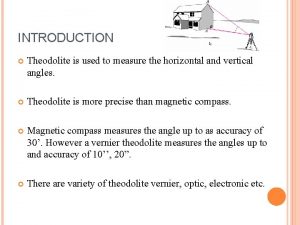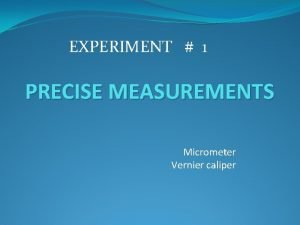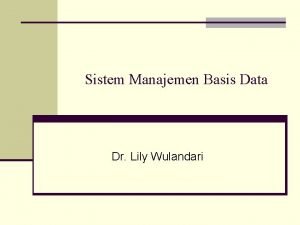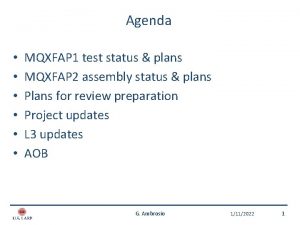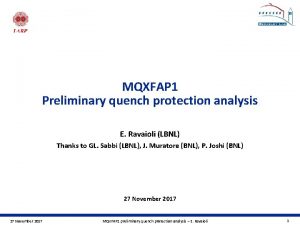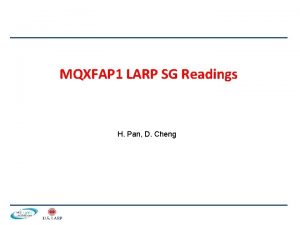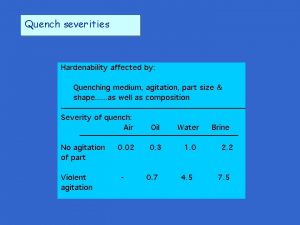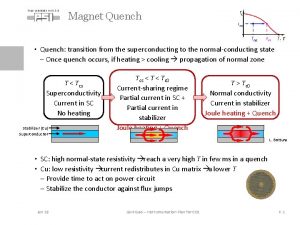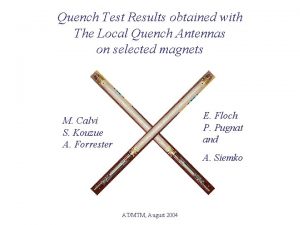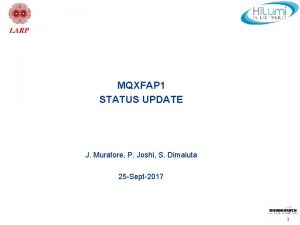MQXFAP 2 SG Readings Update up to quench


























- Slides: 26

MQXFAP 2 SG Readings ---Update (up to quench #13) H. Pan 10/18/2018 LBNL

MQXFAP 2 SG Gauges Overview Shell 4 Shell 2 Shell: HBM Coil: HBM • Shell: HBM, Vishay Coil: HBM, Vishay Shell 6 Shell: HBM Coil: Vishay Three axial locations: • • • RE MID LE Shell gauges (T & Z): on shell 2, 4 & 6 • HBM gauges: Shell 2, 4, 6 • Vishay gauges: Shell 4 Coil gauges (T & Z): on axial location of 740 mm (LE), 1940 mm (MID) and 3140 mm (RE) from LE. • HBM gauges: Coil LE and MID • Vishay gauges: Coil MID and RE Most of the strain gauges stay alive in the quench tests. • HBM shell 6 Top axial, Coil 102 azimuthal LE initially were found wire broken before cool-down. 2

HBM Gauge Readings---Shell Azimuthal Note: “Quench 0” = 12 k. A ramp prior to training 3

Top HBM Shell Azimuthal Strain • Quench#0 is the 12 k. A ramp. (The name is not easily changed because the legend is made in a loop. ) 104 102 Right Left 106 105 LE view Bottom 4

HBM Gauge Readings---Coil Azimuthal Note: “Quench 0” = 12 k. A ramp prior to training 5

HBM Gauge Readings---Coil Azimuthal LE Inorm = 16. 47 k. A LE RE • Coil 102 LE is gone before cooldown • The slope of the available gauges are similar which is about 1000 με from 104 102 105 106 0 A to nominal current. • Coil 104 LE seems to be the 1 st one to show slope change. • Ratchet effect is observed: coil azimuthal strain without current creeps LE view towards less loading over quench tests. 6

HBM Gauge Readings---Coil Azimuthal MID Spike seen in other gauges in the 12 k. A ramp LE RE • Spike seen in other gauges in the 12 k. A ramp Inorm = 16. 47 k. A The slope of the middle coil gauges are close, which is about 1000 με 104 102 105 106 from 0 A to nominal current. • Unstable signals were observed in C 102, C 105 and C 106. • Ratchet effect is observed: coil azimuthal strain without current LE view creeps towards less loading over quench tests. 7

Some Suspicious Phenomenon-spikes • Quench #0 represents the 12 k. A ramp. • Those spikes are clearly correlated; • The other signals do have those spikes; • The connectors of those signals are not close. Inorm = 16. 47 k. A 8

A “global” event seen during the 12 k. A ramp “Quench 0” prior to training 9

Some Suspicious Phenomenon--axial strain drop at 12 k. A ramp Shell Axial Strains Inorm = 16. 47 k. A Axial strain drop of ~50 µε in all shells in 12 k. A ramp Evidence of axial strain decreasing after each quench in some gauges Shell Top Axial RE is lost 10

Some Suspicious Phenomenon--axial strain drop at 12 k. A ramp Coil Azimuthal Strains Spike seen in other gauges at about ~7 k. A 12 k. A ramp Evidence of azimuthal strain increasing after each quench in most gauges • Spike seen in other gauges Inorm = 16. 47 k. A Spike seen in other gauges There seems to be a global event in the 12 k. A ramp 11

Some Suspicious Phenomenon--axial strain drop at 12 k. A ramp Coil Axial Strains Inorm = 16. 47 k. A Spike seen in other gauges at about ~7 k. A • There seems to be a global event in the 12 k. A ramp 12

Additional Shell Strain during 12 k. A ramp Shell azimuthal -- MID Shell azimuthal -- RE Shell azimuthal -- LE Azimuthal changes ~5 -10 µε, compared to ~50 -75 µε in axial Shell axial -- LE Shell axial -- MID • Shell axial -- RE Both LE and MID shells have the signs of “slip” 13

Additional Coil Strain at 12 k. A ramp Coil azimuthal -- LE Coil azimuthal -- MID Offsets of ~5 -10 µε observed Coil axial -- MID Coil axial -- LE • Both LE and MID Coils show signs of event; only MID gauges showed offsets 14

HBM Rod Strain • Quench #0 represents the 12 k. A ramp. • The absolute strain is much offset from the value it’s ought to be. • The delta strain in ramps is close to the magnitude of FEA predictions. • The kink is not explainable at this moment. Delta Strain Actual Strain Inorm = 16. 47 k. A Raw data from 12 k. A ramp Value change at the same moment Polarity is reversed; 15

Vishay Gauge Readings---Shell Azimuthal Note: No “Quench 0” shown here 16

Vishay Gauge Readings---Shell Azimuthal MID Top LE RE 104 102 Right Left 106 105 LE view Bottom Inorm = 16. 47 k. A • MID shell azimuthal gauges behave as expected in trainings. • No obvious slope change or offsets observed. 17

Vishay Gauge Readings---Shell Axial MID Top LE RE 104 102 Right Left 106 105 LE view Bottom Inorm = 16. 47 k. A • MID shell azimuthal gauges behave as expected in trainings. • No obvious slope change observed. 18

Vishay Gauge Readings---Coil Azimuthal Note: No “Quench 0” shown here 19

Vishay Gauge Readings---Coil Azimuthal Inorm = 16. 47 k. A • The linear slope of the middle coil gauges are close, which is about 1000 με from 0 A to nominal current. • Slope change is observed. 20

Vishay Gauge Readings---Coil Axial Inorm = 16. 47 k. A 21

Compare with MQXFAP 1 Coil Strain • Coil 104 LE seems to be the 1 st one to show slope change. • The pre-stress of MQXFAP 2 seems to be slightly higher than MQXFAP 1 a. MQXFAP 2 Coil 104 LE MQXFAP 1 a Coil 3 RE MQXFAP 1 a Coil 4 RE MQXFAP 2 Preload Proposal 22

Rod Gauge Readings 23

Rod Gauge Readings HBM gauges --- only available on Rod 1 Rod 2 Rod 1 Rod 3 Rod 4 • 5. 1” from the rod end (lead end) Vishay gauge --- always facing radially outward in the magnet LE view Vishay HBM • Vishay The HBM gauge are 90 degree with respect to the Vishay gauge on the same rod. Ø FEA: The Δε in rods during ramps with the frictional coefficient 0. 2 is 56 µε; Vishay HBM gauge is on the natural position if there is bending or end effect on the rod. • The HBM reading is close to the FE prediction. • Slope changes were observed in both type of gauges. However, the slope changes did not take place at the same moment on the two positions. 24

Extra MQXFAP 2 Preload Proposal 25

HBM Coil Axial Strain • To verify the magnet axial stretch in ramps, the coil axial strain in all stations is close to the calculation. • The magnet axial stiffness is as predicted. p The measured rods’ strain is likely to be very local according to the magnet axial stretch in the trainings. p Detail analysis in underway on the rod behavior. 26
 Immediate update and deferred update in dbms
Immediate update and deferred update in dbms Love is stronger than death poem
Love is stronger than death poem Plan 11 seal flush
Plan 11 seal flush Lhc quench
Lhc quench Sealed quench furnace details
Sealed quench furnace details Normal blood gases
Normal blood gases Kinds of reading skills
Kinds of reading skills Language awareness readings for college writers
Language awareness readings for college writers How to read ammeter
How to read ammeter How to read a graduated cylinder
How to read a graduated cylinder Theodolite least count
Theodolite least count Christmas responsive reading
Christmas responsive reading Confined space gas limits
Confined space gas limits Normal ecg readings
Normal ecg readings Eb = p x a x t
Eb = p x a x t Vernier caliper experiment readings
Vernier caliper experiment readings Responsive reading for thanksgiving
Responsive reading for thanksgiving Rad 57 co readings
Rad 57 co readings Jcu map
Jcu map How to write keratometry readings
How to write keratometry readings Pastequick user ghost
Pastequick user ghost Deferred update
Deferred update Zechariah 4:8
Zechariah 4:8 Multiplicative weights update algorithm
Multiplicative weights update algorithm 508 refresh
508 refresh Rational clear case
Rational clear case Mentor update yorkshire
Mentor update yorkshire








